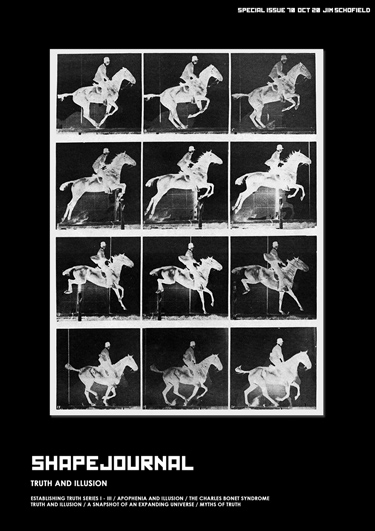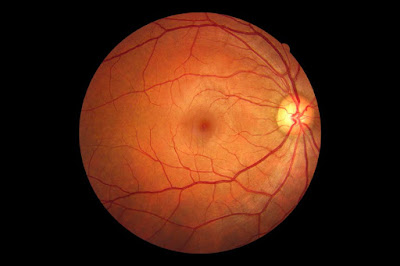This paper is taken from Special Issue 70 of SHAPE Journal: Truth and Illusion.
The Charles Bonnet Syndrome
Discoveries of the Vision/Brain System caused by significant Loss of Vision
I am a scientist and an octogenarian. I currently suffer from an affliction known as Charles Bonnet Syndrome, caused by macular degeneration.
“Charles Bonnet syndrome (CBS) is a disease in which visual hallucinations occur as a result of vision loss. CBS is not thought to be related to psychosis or dementia and people with CBS are aware that their hallucinations are not real.” Rarediseases.info
As an extensively-experienced researcher in both science and philosophy (and their inter-relationships, and cross- causalities) - as well as being a prolific investigative writer of serious academic papers in both of these areas - I felt I was in a unique position to shed some light on this disease, and the insights it offers into how we understand the world visually.
I have a particularly well-endowed background to both accurately describe the changing symptoms involved, and (it seems to me), I possess a unique and necessary ability to draw conclusions, wholly absent from either the usual sufferers or medical practitioners - to play a role in extracting more informatively, exactly what is going on in this less than perfect, and undoubtedly failing system of diagnosis and treatment.
Indeed, it reminds me of the conclusions drawn, many years ago, by V. S. Ramachandran - whose work I have followed closely - from the clinical evidence of both Blind Seeing and Visual Neglect, concerning the Brain Functions involved, and dependable conclusions on how hallucination is actually a fundamental part of vision.
 |
| V S Ramachandran |
My credentials are actually somewhat understated in the above brief description of my professional career. The last 20 years of my life have been dedicated to understanding the philosophical limitations of all Pluralist Science - a pervasive logic which sees laws as separable, but is blind to the dynamics of Qualitative Change, due to its primary methods of analysis - holding things still and making extractions. Plurality regularly generates untranscendable contraditions and impasses in our understanding, but science is fundamentally pragmatic and finds workarounds, but without ever resolving the underlying problem of its failure to deal with real-world change.
This is certainly relevant to understanding my condition, as the Charles Bonnet Syndrome is about the dynamic interface between signals from cells in the retina of the Eye, to regions of the Brain with the capabilities to construct adaptable, and developable visual models (“as cerebrally-viewable images”), which is what we actually “see” and consider, and which is both constantly-updateable and stable as a kind of “movie” in our minds, and could be called upon when required in both the immediate present, and the distant future as visual memory.
And this is well beyond what any Pluralist Science can possibly cope with! But, what could be the requirements of an alternative Holist Science, one that could comprehend this mental movie? For, it certainly WILL NOT BE as a sequence of stills (as in Film) OR even as a sequence of mini-movies (as in Analogue Video)! NOTE: I studied the dynamic qualities of both of these electronic media as part of my extensive research into Dance Education and Motion Studies, with Bedford Interactive in the 1990s.
What will it have to be then, to be useable, as we know it is in the brain, and specifically, how will it perform as evidenced by the actions of The Charles Bonnet Syndrome?
And the more incidents I experience due to the condition, the more complicated and various are the functions that are demonstrated. So, rather than using the selected examples from a clearly diverse range of accounts, some of them are either remembered or can be somewhat embroidered - to avoid the misleading consequences of such misleading evidence - I will instead commence my own contributions with a range of my own experiences, as a professional scientist and multi-discipline researcher, only recounting what I have personally experienced, and also judging what I consider valid enough to be included, if and only if, an explanation is forthcoming!
Let me start by describing the various types of hallucination I have experienced myself.
This is certainly relevant to understanding my condition, as the Charles Bonnet Syndrome is about the dynamic interface between signals from cells in the retina of the Eye, to regions of the Brain with the capabilities to construct adaptable, and developable visual models (“as cerebrally-viewable images”), which is what we actually “see” and consider, and which is both constantly-updateable and stable as a kind of “movie” in our minds, and could be called upon when required in both the immediate present, and the distant future as visual memory.
And this is well beyond what any Pluralist Science can possibly cope with! But, what could be the requirements of an alternative Holist Science, one that could comprehend this mental movie? For, it certainly WILL NOT BE as a sequence of stills (as in Film) OR even as a sequence of mini-movies (as in Analogue Video)! NOTE: I studied the dynamic qualities of both of these electronic media as part of my extensive research into Dance Education and Motion Studies, with Bedford Interactive in the 1990s.
What will it have to be then, to be useable, as we know it is in the brain, and specifically, how will it perform as evidenced by the actions of The Charles Bonnet Syndrome?
And the more incidents I experience due to the condition, the more complicated and various are the functions that are demonstrated. So, rather than using the selected examples from a clearly diverse range of accounts, some of them are either remembered or can be somewhat embroidered - to avoid the misleading consequences of such misleading evidence - I will instead commence my own contributions with a range of my own experiences, as a professional scientist and multi-discipline researcher, only recounting what I have personally experienced, and also judging what I consider valid enough to be included, if and only if, an explanation is forthcoming!
Let me start by describing the various types of hallucination I have experienced myself.
1, The Mini Movie
This invariably occurred upon waking and opening my eyes. But, it wasn’t a misinterpretation of “things- seen”, for it was there wherever I looked, and was always containing the very same subject matter. But, uniquely, it was always in full-detailed colour and excellent resolution - a perfect illusion, always of the same restricted scene, but with minor differences. It was always of a Victorian slate roof, containing one or two brick-built chimney stacks, surmounted by ceramic tops, all with the same kind of zig-zag heads. And, invariably, there would be a branch of a tree, with large glossy leaves being blown about in the wind. But that was it! In a way it was beautiful, but like a repeating movie scrap! Surprisingly it was always framed, as if seen through a window. and wherever Iooked it was there! But it always soon faded and was gone.
2, The Misinterpreted Tile
This, latterly as my sight has become very poor, is clearly a rather poor version of something actually seen, but in these cases it fills-in where my macular is detecting nothing. Very recent versions occur when a glance to a new place immediately sees a hole (that is - nothing there at all), and then rather quickly fills it with the circumstances close to the tile from actually seen views near to that hole! But my looking elsewhere and using the part of my right eye macular, still partially working, you can confirm that the patch is wrong.
With further deterioration, it has now become a major problem, as it can deliver buildings or trees to the view, when it should be the sky!
3. The False General Tiling
In relatively poor lighting conditions, a misinterpreted patch from an extended same view, will then fill-in-and-maintain, wherever I look in that extended view with a regular tiling of the same “tile”, this giving it a pattern which isn’t actually there.
4, The Simplified Tiling
If I look intently at a patterned surface or curtain, it simplifies successively (if I continue to stare) into a series of different, but repeated sets, wherever I look. And, surprisingly, the images, then consist mostly of black lines upon a white background, but they are so beautiful. It’s a real shame I can’t “capture them”!
Now, as with Ramachandran’s conclusions upon brain-activity areas, with normal seeing, the revelations of the Charles Bonnet Syndrome sufferers, as seeing functions were damaged, also throws light upon how the brain plays various creative roles in normal sight too.
To consider these phenomena upon sound bases, though, we have to be clear upon the differing functions of both the relatively tiny macular areas of the Retina within the eye, and the much larger non-macular area, which occupies the whole of the rest of the Retina. It has become clear that we actually see literally ALL detail via the Macular part of the Retina - these are the only areas naturally delivering everything we see in any detail: whereas the rest of the retina is only well equipped for detecting the movements seen by our eyes.
[Whereas, as the focus of seeing is moved elsewhere, a simplified-and-unchanging version is always left behind in all past positions, in the now non-macular areas of the Brain-image. Clearly that part of the brain-image must all be derived from prior macular attention to such areas. The non-macular brain-image is therefore initially composed of “macular-sized patches” delivering the whole of the non-macular brain-image]
So, immediately, anything no longer being picked up by the macular will NOT now show moment-by-moment changes there. Indeed, it will show what was there the last time we looked at that area, via the macular, BUT, as the non-macular does deliver movement, it will have, in some way, to update that non-macular view!
But in addition, evidence from Charles Bonnet sufferers, reveals an extra fill-in function, by copying in a now- absent-view from immediately adjacent areas.
While the rest of the non-macular view is always rotated according to a previously-learned “algorithm”, while still updating movements anywhere upon that area, as our view is moved on.
Now, some of the built-in mechanisms for updating the brain-image of a looked-at-view, have only been revealed by sufferers of the this Syndrome, particularly when the incoming image delivered by the eye is deemed inadequate, for the initial solution is to fill-each-gap with the same content, indeed as that of a close nearby spot (either a reliable one, or a compromise inaccurate one).
In the latter case, it is revealed to be from the immediately priorly-vistited “patch” - so that in an erroneous viewed area, the moving glance of the viewer will merely leave a trail of identical patches determined by the eye’s line of scanning. So, if I as a sufferer, are not sufficiently careful, the brain can fill whole areas of sky with a fiction of recently observed trees!
Charles Bonnet Syndrome is a very specific form of pareidolia - or visual apophenia. This means that it is evidence of a general tendancy of the brain to invent things in order to make sense of random or meaningless information. For Charles Bonnet sufferers, this is experienced as profound hallucination. In people without sight loss these mechanims are still present, but largely hidden, as the stream of visual information given to us by our eyes is complete enough to correct any mistakes or strange inventions made by the brain. Seeing faces in the dark is an example of pareidolia working under normal sensory conditions. People undergoing prolonged sensory deprivation can also experience hallucinations, similar to Charles Bonnet sufferers, as we see with a phenomenon called Prisoner’s Cinema, in which inmates kept in solitary confinement begin to see strange light shows on the walls of their cell.




No comments:
Post a Comment